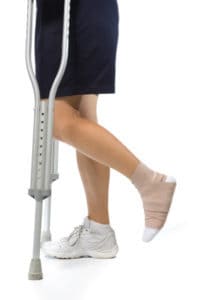Glenn Dale physical therapists highlight the importance of rehabilitation following foot surgery

August 5, 2016
Each of our feet consists of 26 bones and—along with the ankles—has the tall task of supporting the weight of our entire body. Due to their placement and heavy responsibility, the feet are vulnerable to a number of injuries and conditions that can complicate any activities that involve them. Our Glenn Dale physical therapists explain the treatments used for some of these issues and the role that physical therapy plays in the process.
Some foot-related problems develop naturally, without any fault at all of the individual. These are called congenital deformities, meaning they existed at or before birth, and they include flatfoot and clubfoot. Others, like bumps on the side of the foot called bunions, usually result from a combination of both natural factors like the shape of the foot and other factors like footwear choice. Finally, there are injuries like plantar fasciitis and Achilles tendinitis that occur due to regular habits. In most cases people get these injuries when they train too aggressively without taking enough time to recover.
Treatment for each of these injuries and conditions will vary depending on its type and level of seriousness, but in most cases the first approach is conservative, or non-surgical treatment. This usually includes some physical therapy, as well as modification of activities and other habits that can be making the condition worse.
If cases when conservative treatments don’t lead to improvements, however, surgery may be considered as the next step in the treatment process. Patients should carefully discuss the possibility of surgery with their doctor, and understand that it should only be used as a last resort. In general, surgery is performed to alleviate any discomfort and restore the function of the foot. There are a number of surgical procedures for different foot conditions, some of which include bunionectomy for bunions, surgical fusion for arthritis of the foot, and reconstructive surgery for a variety of conditions.
How our Glenn Dale physical therapists treat patients recovering from foot surgery
Following surgery, physical therapy is typically recommended as a vital part of the recovery process, and its goal is to help patients restore their walking ability and return back to their daily activities. Programs will differ depending on the type of surgery, but our Glenn Dale physical therapists generally treat patients recovering from foot surgery with the following:
- Swimming/aquatic exercise: since it may take some time before you can put pressure on your foot again, exercising in the water is a great way to begin your exercise program
- Stretching exercises: lack of movement from the injury and post-surgery can lead to stiffness and impaired flexibility; these exercises will help to gradually restore the flexibility of the lower leg and foot once it can be moved again
- Strengthening exercises: strength will also be limited during the recovery process, so rebuilding strength is another major component of treatment; elastic TheraBand is particularly useful for these types of exercises
- Balance exercises: these exercises will focus on improving your ability to walk and stand as you did before your injury or surgery once again
Most people would prefer not to have surgery, and nobody should unless it’s absolutely necessary. If you do decide to have a surgical procedure for your foot condition, though, be sure to see a physical therapist afterwards to help you along in the rehabilitation process. Our Glenn Dale physical therapists are here to give you advice on treatment for any foot conditions, and to provide effective treatment after surgery if that route is followed. Contact CAM Physical Therapy and Wellness Services, in Laurel, Hyattsville, Glenn Dale/Bowie and Parkville/Baltimore, MD at 301 853-0093 to schedule an appointment today, or click here for more information on recovering from foot surgery.